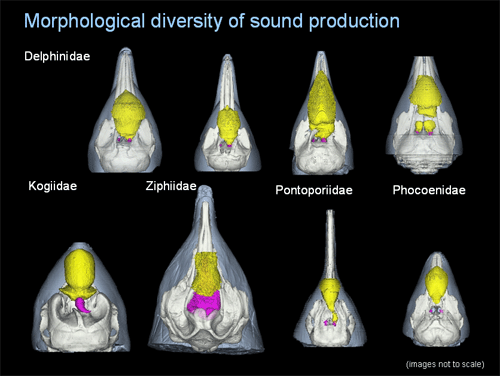
 Dorsal view of the biosonar apparatus in living odontocetes (melon highlighted in yellow, sound source in pink) 
Extinct, early odontocetes (toothed whales). Prosqualodon and Squalodon could probably echolocate like living odontocetes, while Simocetus probably did not echolocate as well. |
"Fossil toothed whales provide clues to how this system evolved because they show us the features that early toothed whales had to work with, if they were able to echolocate at all," says Nicholas Pyenson, a graduate student at University of California, Berkeley. "Based on the fossil record, we know how ears and brains evolved in toothed whales, but the evolution of sound production has been harder to pin down — that's the missing part of the story for the evolution of echolocation," he adds. Pyenson and his colleague Megan McKenna, a graduate student at Scripps Institution of Oceanography, addressed the remaining evolutionary history of sound production by placing the unique skull shapes of fossil odontocetes in the context of detailed knowledge of the biosonar apparatus across a broad sampling of living odontocetes, using X-ray CT scans. "One of the major conclusions from my comparative work on the soft tissue of living odontocetes," says McKenna, "is that living odontocetes species can accomplish the same result of sound generation in different ways, using different orientations and contributions from units of the biosonar apparatus. There's no one way to do it."
Pyenson and McKenna measured specific bony landmarks on the skulls of living toothed whales that reflect functional units of the biosonar apparatus. These criteria included the volume and angle of the nasal passageway and the inferred minimum melon size. Also, the team took into account the evolutionary relationships among the odontocetes in their study, and mapped the results according to an evolutionary tree. Their results show that living odontocetes can be characterized by specific values (e.g., nasal passageway angle > 90°). Extinct odontocetes that were distantly related to living lineages, like Simocetus, had different values for these criteria. "It seems that early odontocetes did not echolocate in the same manner as living ones, but that important parts of their biosonar apparatus were likely already in place," says Pyenson. The authors plan to compare their results on how and when sound production evolved in toothed whales with the existing data on the auditory and brain evolution of cetaceans. Together, these different lines of evidence will give a better picture of the steps involved in the evolution of biosonar in toothed whales. "It's important to see modern biosonar as a system that didn't appear fully integrated overnight, but rather as a suite of different interacting parts that evolved over time," McKenna adds.